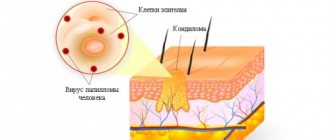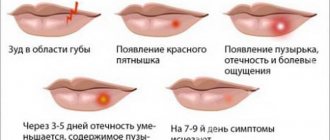Causes of appearance and stages of development
The main root cause why boils develop in pregnant women is a decrease in the body's protective functions during gestation. After conception, large-scale changes occur in a woman’s body, hormonal levels change, and changes affect the immune system. The skin is no longer able to fully perform its functions, the protective barrier is also reduced, as a result of which pathogenic microflora causes inflammation, which provokes the development of furunculosis. Infection occurs in 3 stages:
- A subcutaneous infiltrate develops due to infection getting there. Swelling occurs around the seal, the skin becomes inflamed, and pain occurs.
- After 2-3 days, pus forms at the site of inflammation, and a rod forms inside the boil. The woman’s health worsens, her temperature rises, and the area of the lump swells and hurts. This stage is the most unsafe, since due to intoxication the body of the woman and the fetus is poisoned. If there is a deterioration in health, an operation is performed during which the chiri are removed.
- When the boil has matured sufficiently, a purulent mass breaks out of the wound, and when the wound is completely cleansed, healing will begin, during which careful care of the damaged area is required.
Get a photo of the boil
The development of furunculosis results from the penetration of Staphylococcus aureus into the skin. This type of pathogen has the property of not only burrowing into the dermis, but also living in it for a long time, without radically manifesting itself. The appearance of a boil during early pregnancy occurs when exposed to certain factors:
- Piercing the integrity of the skin is the most common organ.
- During pregnancy, a woman’s body is subject to severe stress, which leads to a decrease in immunity.
- Metabolic disorder.
- Failure to comply with personal hygiene rules.
- Inadequate and unbalanced nutrition, in which important elements are missing from the diet.
- Incorrectly, that is (i.e.) untimely treated staphyloderma and streptoderma.
Causes and mechanisms
A boil during pregnancy is the result of a bacterial invasion. Microbes - mainly staphylococcus - penetrate into the mouth of the hair follicle and provoke purulent inflammation there. The infection develops primarily (in unchanged skin) or against the background of an existing pathology (folliculitis, eczema, dermatitis). In the first case, there are a number of factors contributing to the development of a boil:
- Skin contamination.
- Neglect of personal hygiene.
- Increased sebum and sweating.
- Minor injuries (abrasions, scratches, abrasions).
- Incorrect selection of cosmetics.
The weakening of the barrier properties of the skin and, as a result, increased susceptibility to microbial agents is often provoked by systemic changes in the body. During pregnancy, hormonal and immune changes are observed, vitamin deficiencies and exacerbation of chronic pathology are common. All this creates favorable conditions for pustular skin diseases.
The development of boils during pregnancy is caused by staphylococcal infection and a decrease in the body's reactivity.
Features of treatment of boils during pregnancy
Often a boil appears in the groin area during pregnancy. Less commonly, furunculosis affects the limbs, abdomen, and back.
If signs of illness occur, you need to sound the alarm. Main symptoms:
- itching;
- thickening of the skin surface;
- the appearance of painful nodules;
- the appearance of ulcers and edema.
A boil in the groin in pregnant women is a health hazard. In this area, the tissues are more delicate, there is intense blood circulation and a large number of nerve endings; the spread of the disease is painful.
The formations are often complicated by abscesses. When an abscess forms in the thickness of the epidermis, a capsule appears filled with purulent contents. This is a protective reaction of the body that limits weight from healthy tissue.
Staphylococcus aureus lives on the surface of the skin and mucous membranes for years without making itself felt.
Factors influencing the appearance of boils in the groin:
- violation of the integrity of the skin;
- decreased immunity during pregnancy;
- changes in metabolism;
- lack of personal hygiene;
- poor nutrition, lack of vitamins and microelements;
- improper and untimely treatment of streptoderma.
The appearance of a boil on the inside of the wings of the nose in a pregnant woman is a consequence of pathogenic microflora entering the hair follicles. Staphylococcus aureus provokes the development of boils. Growths can be caused by:
- temperature increase;
- the appearance of chills;
- headache.
The disease is aggravated by nearby blood vessels, through which microbes quickly penetrate and spread throughout the body. Treatment is complicated by difficult access to the site of the disease. When the boil is small in size, the disease has a favorable outcome. In advanced cases, the help of a doctor is necessary.
The appearance of boils during pregnancy in the ear canal of the ears begins with itching at the site of inflammation. Next, redness of the skin and swelling occurs. When pus appears, the pain increases, pain radiates to the back of the head and jaw. Edema is characterized by the appearance of a “white head” at the epicenter of inflammation – the core. As the process progresses, the parotid, postauricular and cervical lymph nodes enlarge.
Boils on the labia during pregnancy are rare. This disease can be caused by careless shaving of the intimate area, cuts, or scratching.
You cannot remove a boil yourself. The affected area must be treated with antibacterial drugs and a bandage made with Ichthyol ointment. If you have a problem, you need to consult a gynecologist to prescribe prompt treatment.
When treating boils, the doctor must be careful in his actions. The disease requires mandatory consultation with a doctor. Due to a decrease in immunity, the spread of infection can be rapid. It is unacceptable to resort to independent home treatment; there is a high probability of serious complications.
In the early stages of pregnancy, doctors prescribe drug treatment for boils, which is often based on taking antibiotics. Parenteral administration of drugs is rarely prescribed; this occurs in cases of infection spreading throughout the body.
During pregnancy, you can choose hydrogen peroxide, Chlorhexidine, Betadine. Apply the products with caution, trying not to get on the mucous membranes of the mouth and eyes. Before the procedure, you should follow the rules of hygiene; your hands should be washed with soap and treated with an antiseptic to eliminate the possibility of infection.
It is forbidden to apply warm compresses or squeeze on boils. Such activities will increase the spread of infection in the skin. The doctor, when opening boils, will install drainage if necessary, apply a bandage with an antimicrobial drug, be sure to take into account:
- gestational age;
- the possibility of complications during pregnancy;
- consequences for the mother and fetus.
Doctors often use Levomekol or Vishnevsky ointment, which have no contraindications. If there are no results from drug treatment, an autopsy is performed surgically.
When the boil opens, antibacterial therapy is prescribed. For a favorable pregnancy outcome, you need probiotics and vitamins. The composition of medications is selected individually by the attending physician, and administration is carried out under supervision. Vitamin preparations help improve the immunity of women and children.
Boils during pregnancy should be addressed to a doctor immediately as soon as they begin to appear.
It is important to be very careful, c) to the extent that a boil appears during pregnancy, it requires immediate and proper treatment. You definitely need to see a surgeon. Due to the fact that immunity decreases during pregnancy, the infection can quickly spread throughout the body.
In early pregnancy, the doctor may prescribe drug therapy, often prescribing the use of a local antibiotic. In very rare cases, oral antibacterial drugs are recommended if the infection has spread throughout the body.
If the abscess has passed into the infiltration stage, I will not be treated with antiseptic solutions. This procedure must be carried out every day. Hydrogen peroxide, dollars or chlorhexidine are ideal for disinfection. The product is applied very carefully in order to prevent damage to healthy skin. Before this procedure, you must wash your hands with soap and at the end treat them with an antiseptic, so as to prevent self-infection.
In the age of infiltration, it is permissible to carry out treatment using physiotherapeutic methods - UHF, laser. The doctor selects a treatment regimen strictly on an individual basis. In most cases, the duration of course therapy is 5–10 days.
- trimester of pregnancy;
- the nature of the pregnancy, whether there are any complications;
- what consequences may (re)exist for the child and the woman.
In most cases, doctors prescribe ointments that do not cause any harm to either the fetus or the expectant mother. Most commonly, Levomekol or Vishnevsky ointment is used. Local treatment is prohibited throughout pregnancy.
When the boil opens, all the pus is removed using a clean cotton pad, then the wound is disinfected. The skin around the abscess is carefully lubricated so as not to spread the infection to healthy areas. An open scar must be covered with a sterile and dry bandage.
A pregnant woman can be prescribed multivitamins, which prevents the development of dangerous consequences of inflammation in the form of a boil. Only a doctor selects the best composition, so it is worth looking for such drugs on your own. Vitamin complexes supply the body of women and children with all the necessary elements that contribute to a complete and rapid recovery.
Certain medications designed to activate the immune system may also be prepared. The independent use of immunomodulators is strictly prohibited, as they are very heavy and can provoke a serious malfunction in the functioning of a woman’s body.
If drug therapy does not give a positive response, the boil is treated surgically. The affected area, along with the purulent masses and tissue around it, are removed. The entire procedure is carried out under local anesthesia. The optimal time according to rumors is from 14 to 32 weeks.
If the disease progresses actively, surgery is performed for no reason during pregnancy. After the surgical intervention has been performed, the pregnant woman remains under the supervision of a doctor for some time. Local antibacterial therapy is prescribed.
Treatment
It is impossible to treat a boil during pregnancy with tablets due to existing contraindications. Therefore, boils during pregnancy are treated with topical agents. At the infiltration stage, the abscess is treated with 5% tincture of iodine or an alcohol solution. At the stage of boil formation, ichthyol ointment or pure ichthyol is applied under a bandage. This accelerates the maturation of the boil. When an abscess breaks through, the wound is treated with 3% hydrogen peroxide to remove the accumulation of pus. For better drainage of purulent contents, a gauze bandage with an isotonic NaCl solution is applied to the opened boil. At the healing stage, the wound is lubricated with fucorcin or a solution of brilliant green.
In extreme cases, when the health and life of the woman and fetus are at risk, the doctor prescribes immunostimulants, anti-inflammatory drugs, and antibiotic therapy.
Furunculosis is an inflammatory process of the hair follicle, leading to intoxication of the entire body due to the accumulation of pus. This condition is considered extremely dangerous for the health of a pregnant woman and the development of the fetus. Based on this, you should consult a doctor at the first sign.
Symptoms
The main symptom that characterizes furunculosis in pregnant women is the appearance of a purulent neoplasm, which occurs in 3 stages and lasts about a week. But it happens that a boil forms without a purulent core inside, then the inflamed area turns red and hurts when pressed. If a boil develops in the groin during pregnancy, under no circumstances should you self-medicate and try to get rid of the suppuration.
If a pregnant woman experiences frequent and prolonged boils, she should go to a medical facility for testing and an ultrasound examination of the disease.
Furuncle during pregnancy: treatment and consequences for the child – Derma
Pregnant women are susceptible to boils just like everyone else, but their treatment, in this case, has some peculiarities.
The danger of a boil during pregnancy
A furuncle or boil during pregnancy is an extremely unpleasant phenomenon that can be found in absolutely any area of the body, including the groin. Naturally, the first question that worries expectant mothers is whether the boil will cause harm to the fetus and whether it will affect its intrauterine development and the future health of the child.
The danger of a boil during pregnancy
As you know, boils can be single or multiple. In the second case, as a rule, they talk about furunculosis.
Regardless of the nature of the appearance of boils, a pregnant woman should consult a doctor for qualified medical help with this problem and not self-medicate.
The most dangerous form of furunculosis for pregnant women is the chronic form of furunculosis, in which the appearance of boils is widespread. But, with untimely and improper treatment, even a single boil can become a huge danger for both the mother and the unborn child.
For what reasons do boils appear in pregnant women?
Also, as in all other cases, the root cause of a boil in a pregnant woman is an infection, which is characterized by the entry of Staphylococcus aureus into the body. A feature of pregnant women is frequent damage to the skin, for example, due to rubbing it with a bandage. Also, the secretions of various glands increase, which can also cause the appearance of boils.
For what reasons do boils appear in pregnant women?
During pregnancy, a number of changes occur in a woman's body. In particular, metabolism may be disrupted, metabolism may decrease, which can also cause boils.
Photo of a boil during pregnancy
Photo of a boil during pregnancy Photo of a boil during pregnancy Photo of a boil during pregnancy
How to treat boils during pregnancy
As we noted above, the first thing a pregnant woman should do when a boil appears is to consult a doctor. It is a competent specialist who should prescribe a treatment that will have a minimum of negative consequences and side effects.
How to treat boils during pregnancy
Boils in pregnant women are almost never treated with antibiotics, instead of which other drugs are used to accelerate ripening.
Pregnant women with boils must follow a special diet and exclude fatty and spicy foods from their diet.
How does a boil manifest during pregnancy?
Only those people who have previously encountered them can notice the appearance of boils in a timely manner. Everyone else considers a boil to be an ordinary pimple until it reaches a significant size and the inflammatory process begins in the surrounding tissues.
How does a boil manifest during pregnancy?
That is why pregnant women should be very careful about any skin rashes.
Boils during pregnancy can appear on absolutely any part of the body, but most often they are diagnosed on the back of the neck and in the armpits.
How does a boil manifest during pregnancy?
If furunculosis in pregnant women is chronic, then boils form constantly, both individually and in whole groups. If the disease is acute, then several boils appear at once, and their number can be quite large.
Boil during pregnancy under the armpit
A boil under the armpit in pregnant women appears due to increased sweating, as well as poor hygiene. Its first signs are redness of the skin and swelling.
When you move your hand, you feel discomfort and burning.
The armpit differs from other areas in that, unwillingly, it is constantly in motion and the boil in this place will be constantly compressed, which can cause the development of inflammatory processes.
Furuncle during pregnancy: what is the danger for mother and child
A boil during pregnancy is dangerous not only for the mother, but also for the fetus due to the negative impact of the inflammatory process on the body.
Furuncle during pregnancy: what is the danger for mother and child
Particularly dangerous are abscesses in which the suppuration becomes large. Also, if boils are not treated in a timely manner, blood poisoning is possible, which poses a direct threat not only to the health, but also to the life of the mother and child.
Taking medications without medical supervision, especially antibiotics, can also negatively affect the condition of the fetus.
In order to maximally protect the unborn child, surgical removal of the boil is often prescribed during pregnancy.
Patient review
How does a boil manifest during pregnancy?
Before pregnancy, I never had to deal with such a problem as boils.
Therefore, when, in the 5th week of pregnancy, three pimples appeared on my pubic area at once, causing incredible pain, I was very scared and went to the doctor, who told me that they were boils.
I managed to cure the first boils on my pubic area quite quickly with the help of Vishnevsky’s ointment, however, after a few weeks new ones appeared, already on the labia, and from them I felt very unwell and my body temperature increased.
As a result, I even had to go to the hospital where I underwent a course of treatment, after which the doctors assured me that there was no longer any threat to the fetus.
If you are pregnant, then do not treat boils yourself without consulting a doctor, and especially do not try to squeeze them out, otherwise you will get furunculosis instead of one boil.
Source:
Furuncle during pregnancy: does it affect the fetus and what to do in the early stages?
Furunculosis is an inflammatory process of the hair follicle, leading to intoxication of the entire body due to the accumulation of pus. This condition is considered extremely dangerous for the health of a pregnant woman and the development of the fetus. Based on this, you should consult a doctor at the first sign.
Causes and symptoms in pregnant women
A single occurrence of a boil is considered a mild manifestation of the disease; with the appearance of a large number, an aggravated form occurs - furunculosis.
In a pregnant woman, due to the characteristics of her body, the disease can become severe. But the main danger is that the pathological process becomes chronic. The infection can pass to the child through the bloodstream, penetrating the placental barrier. Treatment of boils during pregnancy requires promptness and utmost efficiency to prevent infection of the fetus.
From the first days of conception, a woman’s body begins the process of restructuring in order to maintain the pregnancy and prevent embryo rejection. During this period, immune defense is significantly reduced. The body’s strength is not enough to fully fight various infections.
Therefore, the appearance of boils during pregnancy is not uncommon. They begin to fill up after staphylococci penetrate into the skin. An infectious disease develops - furunculosis.
There are several reasons that lead to the formation of boils during pregnancy:
- Skin damage caused by wearing tight clothing.
- Intensive work of the sebaceous glands.
- In the first and third trimester, there is an insufficient supply of vitamins and minerals to the body.
- The presence of inflammatory and infectious skin diseases.
- Failure to comply with personal hygiene rules.
On a note. Pregnancy often leads to metabolic disorders. Dramatic changes in the body provoke the appearance of boils.
How to cure and prevent pathology?
Treatment of furunculosis in pregnant women is complicated by the fact that not all medications are approved for use during this period. Surgical interventions are also highly undesirable at this time. What if treatment is still necessary?
Traditional therapy
The first step, when a problem is detected, is to immediately treat the boil and the skin around it using any antiseptic, for example, brilliant green, iodine, alcohol, hydrogen peroxide. After which you need to consult a doctor. The following treatment is usually prescribed today:
ethnoscience
Before using traditional medicine methods during pregnancy, you should consult a doctor so as not to worsen the condition with allergic reactions, which women are prone to during this period. To exclude such a development of events, an allergy test should be performed. To do this, a small amount of the selected treatment should be applied to the wrist; if after 15 minutes there is no redness, then therapy can begin using this method.
Among the effective and safe means are the following:
Prevention
During pregnancy, a woman experiences many changes that have a negative impact on the body. To minimize the risk of furunculosis, it is necessary to strengthen the immune system. If the expectant mother is prone to this disease, then to prevent infection of the baby, it is necessary to immunize with staphylococcal toxoid during pregnancy. Then, to monitor the effectiveness of therapy, take a culture test for the presence of bacteria.
If a woman has previously had boils, then during pregnancy she should:
A boil during pregnancy is a rather difficult condition; in order to prevent the development of all kinds of complications, when the first signs appear, you should consult a doctor as soon as possible. Competent and timely therapy will help maintain the health of mother and baby.
Localization
The inflammatory process begins with the formation of a slight swelling and redness in those places on the body where there are most hair follicles. After 1-2 days, the lump begins to increase in size, its color becomes brighter, and painful sensations appear when pressed.
At the same time, a bubble forms in the center of the abscess, in which pus is formed. After maturation, the boil opens and its contents flow out along with blood. Healing of the damaged area occurs slowly, as a result, a scar forms at this place.
During pregnancy, boils most often appear:
- In the groin. Women may choose the wrong underwear depending on the physiological characteristics of their body during pregnancy. When wearing tight clothes, constant friction of intimate parts occurs, the skin is injured.
- Under the arm. Increased sweating and poor hygiene lead to the formation of a boil in the armpit. A woman should immediately pay attention to discomfort and burning in these places.
- On the face. A large number of sebaceous glands on the face makes the skin excessively oily. With this type of skin, it is necessary to carry out cleansing procedures frequently, otherwise abscesses will be constant companions. Most often, boils appear on the nose, upper lip and ear area.
Ulcers cannot appear on the palms and soles, because these parts of the body do not have hair follicles.
A boil can form on any part of the body where there is hair. Consequently, the palms and soles are not affected by the disease. The most common areas of the body where ulcers appear are the neck, face, buttocks, chest, armpits, and interscapular area. Less commonly, the disease affects the genital area, ears, and scalp.
In an intimate place
There are a number of reasons for the formation of a boil in pregnant women in the genital area.
The most common reason for the appearance of a boil in an intimate place during pregnancy in women is non-compliance with hygiene standards.
Due to the penetration of infection through microtraumas of the groin area resulting from depilation, insect bites, scratching, and sexual intercourse, a purulent-inflammatory process can develop.
A weakened immune system, vitamin deficiency, and debilitating diets increase the risk of skin pathology.
Increased sweating in combination with a lack of hygiene measures creates favorable conditions for the proliferation of pathological microflora.
High levels of testosterone in women are a predisposing factor to the formation of boils in the labia.
A furuncle during pregnancy in the intimate area can occur as a result of sexually transmitted diseases.
In pregnant women, due to hormonal changes in the body, the risk of developing a genital boil increases, and a decrease in immunity can lead to the formation of several boils in different areas of the skin (furunculosis).
In an intimate place
How to treat?
Naturally, many medications are prohibited during pregnancy. This fact complicates the treatment of boils in pregnant women.
Drug treatment
In the first trimester of pregnancy, it is permissible to use topical antibacterial agents
, for example, Levomekol, Vishnevsky ointment. An antiseptic should also be applied to the affected area; this can be hydrogen peroxide or Chlorhexidine.
Attention!
Independent selection of drugs is unacceptable; only a doctor can prescribe treatment that is effective and safe for the expectant mother and fetus. Before and after applying ointments to the boil, you should wash your hands thoroughly.
Significant spread of infection requires internal use of antibiotics. But the advisability of taking them is assessed by the doctor depending on the test results and the general picture of the disease. In some cases, the immunostimulant Viferon is prescribed.
Surgical intervention
If general therapy does not bring results, the doctor may decide to open the boil. The surgery is performed under local anesthesia, and a gentle drug is selected.
During the procedure, the surgeon cuts off the affected area of skin, cleans the wound of pus and applies an antiseptic to it. After surgery, repeated antibiotic therapy is carried out.
At this time, it is important to monitor the condition of the woman and the fetus.
Surgical treatment of a boil is acceptable in the 2nd trimester of pregnancy, but a progressive disease may require intervention at any time.
A boil is a pustular skin disease, the causative agent of which is Staphylococcus aureus, or, less commonly, white Staphylococcus. The inflammatory process develops in the hair follicle and affects surrounding tissues. It has several stages of maturation: the formation of infiltrate, the process of suppuration and necrosis, scarring. A boil on a woman’s body during pregnancy is dangerous for the development of complications that can negatively affect the course of pregnancy and cause various pathologies in the fetus. Therefore, boils during pregnancy should be treated immediately.
Due to untimely and incorrect treatment of the disease, complications may develop. Boils in the facial area can cause the development of cavernous sinus thrombosis, meningitis, and encephalitis due to infection in the vessels of the brain. When the body's protective function is weakened, multiple lesions of nearby hair follicles (carbuncle) may develop. Infection in the blood leads to the development of sepsis, the outcome of which can be fatal.
During pregnancy, a woman's body undergoes hormonal changes and the immune system weakens. As a result, the female body becomes a target for various pathologies. With a decrease in the protective function of the skin, the development of boils during pregnancy is a common pathology.
Factors predisposing to the development of the disease include:
- increased sweating and sebum secretion;
- microtraumas from scratches, abrasions, scratching through which infection penetrates;
- contact of the skin with pathological secretion, which is formed during inflammatory infectious diseases (rhinitis, frontal sinusitis, etc.);
- errors in compliance with hygiene standards;
- contact with dust, liquid solutions;
- decreased immunity with the development of chronic pathologies;
- metabolic diseases, as a result of which the protective ability of the skin is reduced, which creates a favorable environment for pathogens to exist and reproduce.
Preventive measures
To prevent the period of bearing a child from becoming a stage in the fight against boils, a woman should carefully monitor her health and try to take the following preventive measures:
- regular intake of vitamins and vitamin complexes prescribed by the doctor;
- proper skin care and use of high-quality, safe personal hygiene products;
- correct and timely treatment of minor wounds, scratches, cracks, insect bites;
- When shaving or epilating, use only products specifically designed for this purpose;
- Wearing warm clothes in winter will help prevent hypothermia.
During the period of bearing a child, you should pay special attention to your own health. A woman should eat right, take good care of her skin, and try not to stay in the cold for a long time.
If a pregnant woman still has boils, she needs to urgently consult a doctor who can find her an effective, gentle therapy. After a week and a half, the boil will break out on its own and all the unpleasant symptoms will go away. After a boil breaks out, a pregnant woman should remove all the pus with clean hands, treat the wound with hydrogen peroxide, and cover it with an antibacterial bandage. Since the pus inside the boil is contagious, this treatment will help avoid infection of the entire body.
To avoid relapse of furunculosis during pregnancy, first of all, before conception, you should strengthen the immune system by going on a therapeutic diet and engaging in light exercise. If your health condition allows, hardening procedures will have a positive strengthening effect, which should be started under the supervision of a doctor.
How to get rid
Under no circumstances should you put pressure on a boil or try to squeeze it out yourself, especially if it is located in the facial area, due to the risk of blood poisoning. The patient should contact the doctor observing her and, after his consultation, a specialist who will select the correct treatment taking into account the duration of pregnancy.
Drugs
Treatment of furunculosis during pregnancy should only be under the supervision of a doctor, since a number of drugs (stimulating the maturation of boils, ointments, antibiotics) are contraindicated. To support immunity and increase the protective forces of a woman’s body, vitamin complexes are also selected individually.
To treat the wound at the site of the boil and according to indications, an antiseptic such as Chlorhexidine, as well as Ichthyol and Syntomycin ointments, Levomekol (as prescribed by the supervising doctor) can be prescribed. Staphylococcal bacteriophage is effective for treatment.
Surgical methods
Only a surgeon should remove a boil during pregnancy. An immediate visit to a specialist will be required if, against the background of furunculosis, severe pain occurs in the lower abdomen and blood discharge appears from the genitals. An alarming symptom is persistent fever (more than three days).
An unscheduled visit to a specialist will be required in case of chronic furunculosis and when boils are localized on the face. The surgeon will competently remove the abscess and clean the wound. The procedure for removing a boil is standard. At the healing stage, the woman will need to strictly follow the recommendations for antiseptic wound treatment and personal hygiene.
Is it possible to treat at home?
Since self-medication of boils for a pregnant woman is fraught with serious consequences, the problem should be solved only under the supervision of a doctor. This also applies to the use of traditional medicine. Medicinal plants are in no way inferior to synthetic drugs in strength, so it is dangerous to consider them as a “harmless” adjuvant therapy.
To treat boils, saffron, narcissus roots, beeswax, and a number of other remedies are actually used. For uncomplicated boils, their use will bring positive results. But independent use of such products can be dangerous if you are prone to allergic reactions.
For complications of furunculosis, it is advisable to use only complex treatment prescribed by a doctor. The patient’s task is to strictly follow his recommendations.
In addition to taking medications prescribed by the doctor, you need to check the condition of the boil every day for its maturation. After removal, it is necessary to monitor the healing process by treating the wound, providing hygiene and rest to the problem area (avoid pressure and any damage).
The danger of such abscesses
With local inflammation, staphylococcus cannot reach the fetus and will wedge itself into its development. But it is important to consult a doctor immediately after identifying the problem, who will prescribe standard therapy.
For the fetus, furunculosis is especially dangerous in the first months of pregnancy, when organs and systems are just beginning to develop. In the presence of multiple abscesses and elevated body temperature, a miscarriage is possible.
In severe cases, the disease leads to the development of heart and kidney defects and disturbances in the central nervous system. In the last months of pregnancy, a woman with furunculosis may experience premature labor, develop placental insufficiency, and the child will suffer from hypoxia.
Causes of abscess development in pregnant women
During pregnancy, immunity usually decreases, which makes the body defenseless against various types of infectious invasions. The entry point for the development of infection can be a small wound or abrasion on the skin or mucous membrane. Staph infections can affect the skin of the face, chest, or armpits. Kidney abscess may develop.
An abscess can be complicated by an ingrown nail or a carious tooth. Due to a decrease in the body's immune defense, an abscess can complicate almost any infectious disease in a pregnant woman. That is why it is necessary to constantly be monitored by a gynecologist during pregnancy and take timely measures to prevent abscesses.
When contacting our clinic, a qualified surgeon will examine the woman and prescribe treatment that will be effective and as safe as possible for the fetus.
What symptoms do you see a surgeon for:
- Presence of hernial protrusion
- Daggering pains in the abdomen
- Bloating
- Pain in the right hypochondrium
- Bitterness in the mouth
- Nausea
- Presence of neoplasms on the skin
- Swelling and redness of the skin
- Bone fractures and bruises
- Wounds of any location
- Vomit
- Enlarged and painful lymph nodes
How to recognize the disease?
At the first stage, a small compaction appears in the subcutaneous tissues, which is provoked by inflammation. Swelling becomes noticeable in this area due to tissue edema. The tumor develops within 2–3 days, redness and pain are observed when pressed or touched. At the next stage, tissue sepsis begins in the places where the boil develops, and intoxication of the body manifests itself.
The purulent core, which passes through the skin, takes on a cone-like shape. During pregnancy, an increase in temperature to 38˚ or 39˚ is often recorded. The skin in these places is very sensitive to pain, and they also acquire a bluish-burgundy tint. Toxins spread throughout the body at an accelerated pace and cause serious harm to the baby and mother.
Within 5 or 6 days, the abscess matures, during which time careful observation by a doctor is strongly recommended. Basically, boils are treated at this stage with surgery to prevent intoxication. At the third and final stage, tissue ruptures and pus leaks out.
The chiryak bursts and after all the pus comes out, the wound heals and a scar forms. A boil appears during pregnancy due to decreased immunity; the fetus needs a lot of nutrients, so the mother’s body weakens and becomes vulnerable. On our skin there are many different harmful bacteria that are capable of attacking and at the slightest damage the infection enters the body, thereby provoking the development of the disease.
High temperature accompanies the development of a boil
Symptoms
A boil is understood as a purulent-necrotic inflammation of the hair follicle, glands (sebaceous, sweat) and adjacent connective tissue. This process can develop on almost any part of the skin (head, neck, torso, arms, legs), but most often it affects areas exposed to constant pollution and friction.
The inflammatory process is acute in nature, so it manifests itself quite clearly. A boil during pregnancy first looks like a small lump the size of a pea, painful on palpation. The skin over it turns red and swells. Gradually, the infiltration increases, and burning and pain appear at the site of the lesion.
The second phase of boil development is characterized by the formation of a purulent-necrotic core. A yellow clearing (pustule) appears at the top of the swelling. Pus accumulates inside the boil, causing the boil to take on a cone-shaped shape and become bright red and shiny. This is accompanied by increased pain, which becomes pulsating. Body temperature rises, and signs of intoxication may even appear (malaise, weakness). If the abscess is localized in the external auditory canal, then in addition to the symptoms described above, pain in the ear and a feeling of stuffiness appear.
The process of boil maturation takes an average of a week, and ends with the breakthrough of pus and the removal of the necrotic core. The wound is cleared of pathological masses and heals by scarring within 2–3 days. All signs of inflammation (local and general) disappear. As a rule, single boils are observed during pregnancy, less often the process takes on a multiple character.
Abscesses in pregnant women go through typical stages of development and are accompanied by known signs of inflammation.
Treatment of furunculosis during pregnancy
For pregnant women, boils are a dangerous disease that negatively affects the fetus and the mother’s body. Pathology negatively affects the full development of the child. In severe and advanced cases, fetal death may occur directly in the womb.
For mother
The process of inflammation weakens the body, which is already tired from pregnancy, which leads to the penetration of staphylococcus into the blood and the development of dangerous complications.
When treatment for furunculosis during pregnancy is prescribed incorrectly, relapses are possible. An abscess or cellulitis may occur. Inflammations that are isolated in nature do not pose a risk to the woman in labor and the unborn baby. To recover and prevent the development of the disease, simple treatment will be enough. The appearance of a boil on the skin does not affect the process of pregnancy itself.
For a child
Therapy must be based on the safety of the treatment so as not to harm the child.
With single inflammations, the spread of infection to the fetus is minimal. The main danger is furunculosis with the development of complications. A large number of rashes, with the presence of purulent masses and an increase in temperature, is a consequence of bacteremia and the action of toxins. In particularly difficult cases, doctors insist on terminating the pregnancy.
If the disease appears in the third trimester of pregnancy, early delivery is recommended. The entry of harmful bacteria into the blood often causes sepsis, which often leads to intrauterine fetal death. The sad consequences of boils can occur in all trimesters.
In the 1st trimester of pregnancy, under the influence of a harmful pathogen, there is a high probability of developmental defects in the baby.
In the 2nd trimester, boils are no less dangerous; disturbances occur in the formation and functioning of the cardiovascular system, organs of the nervous, genitourinary and digestive systems. Throughout pregnancy, the risk of premature birth cannot be ruled out.
During pregnancy, treatment of furunculosis becomes more complicated; most medications are contraindicated. Only in rare cases can a doctor prescribe medications if they cannot be avoided. At the second stage of the disease, lotions of iodine or alcohol are used, cauterizing the skin around the suppuration. When the boil breaks through, hypertonic dressings are used to quickly drain the pus.
- Make a compress from boiled or baked onions, first chopping them on a grater or finely chopping them. Apply the resulting mixture to the site of inflammation for half an hour or an hour.
- Mix two tablespoons of glycerin with 250 ml of tomato juice, apply to the boil three times a day and store in the refrigerator.
- The bandage must be soaked in an infused decoction of chamomile and sage, and applied to the boil for half an hour.
- A honey compress is also effective. To prepare it you need a yolk, a tablespoon of flour and a teaspoon of olive oil. Mix the resulting porridge with a tablespoon of honey and melt over low heat. When the whole mixture becomes homogeneous and thickens, cool and apply as a compress.
Yolk, flour and oil are used as a compress for boils
https://www.youtube.com/watch?v=JlPJeIqrxms
Any disease during pregnancy is dangerous, furunculosis is no exception. The mother's immunity is weakened, infections attack the fetus, it is more vulnerable than ever. Anything can affect:
- poor nutrition;
- stress;
- decreased immunity;
- impaired metabolism;
- wounds and scratches on the body;
- increased work of sweat and sebaceous glands.
Subcutaneous suppuration is provoked by food with dyes and flavors, so as soon as you notice inflammation, immediately begin treatment to reduce the risk of developing the disease. During pregnancy, ulcers appear in the intimate area and there they are most often susceptible to abscesses. In areas of skin friction such as knee joints, elbows, etc.
very high risk of developing an abscess. The entry of pus into the blood leads to its infection, then high temperature and fever cannot be avoided. Through the blood, pus can reach the fetus. A child can also catch furunculosis from the mother through milk or blood if he is not yet born. Boils release toxins into the body, which poison the baby.
A neglected boil provokes furunculosis, multiple occurrences of suppuration. The release of boil toxins is very dangerous for mother and child. Immunostimulants are prescribed only in severe cases; do not take them without supervision and advice from a doctor. Abscess due to the appearance of boils in areas of friction of the skin.
Pus comes out of the inflamed area. If a boil breaks out and becomes inflamed under the armpit or on the skin of the face, blood sepsis is possible. Many blood vessels accumulate in this place. During pregnancy, traditional medicine should also be discussed with your doctor. Do not make independent decisions; this can be dangerous for the child and yourself. If you notice symptoms, follow these simple recommendations:
- do not treat yourself, but see a doctor - do not risk the health of the child and your own;
- Medicines should be prescribed by a specialist, do not self-medicate, it can be dangerous;
- a boil during pregnancy is very dangerous, so eat right, don’t be nervous and monitor your general health;
- if you find a boil in an intimate place, visit a gynecologist;
- The disease should not be ignored, it will lead to dire consequences: even if you manage to get rid of one boil, if treated incorrectly, the disease may recur.
Be careful and watch your health. You are responsible for the condition of the child and your own, so you take even such a simple disease seriously.
An abscess is an abscess and a place where pus accumulates. Pus may appear due to acute or chronic local infection. With an abscess, tissue destruction occurs in the area affected by the infection. An abscess can appear not only on the skin, but also inside the body in any organ. When an abscess occurs, a membrane wall is formed, which closes the purulent area from other healthy tissues.
The danger of a boil during pregnancy
For a pregnant woman, furunculosis becomes a dangerous pathology, as it negatively affects the development of the fetus, interfering with its full formation. In the most severe cases, the child dies in the womb. It is important to know how to treat a boil during pregnancy so that recovery occurs and the fetus is not harmed.
During pregnancy, the female body experiences increased physical stress and many processes take place in the body. As a result, the protective barrier of the immune system is greatly reduced. Treatment of a boil during pregnancy takes a long time and is often accompanied by complications.
A boil during pregnancy has a strong negative effect on the fetus, as it provokes a general intoxication syndrome. There are malfunctions in the functioning of the systems and internal organs of the expectant mother. In different localization zones, the body becomes covered with boils. The occurrence of an inflammatory process leads to a weakening of the body, as a result of which it becomes a favorable environment for the penetration of dangerous bacteria and viruses.
If a boil during pregnancy is not treated correctly, the woman often suffers from relapses. The likelihood of disruption of subcutaneous fat by the inflammatory process increases significantly. An abscess or phlegmonous inflammation develops.
For the course of pregnancy and the full development of the fetus, the appearance of single formations does not pose any danger. To quickly get rid of the problem and prevent further progression of the disease, it is enough to carry out simple therapy.
The appearance of a boil on the skin does not have any effect on the course of gestation. With local inflammation, the fetus does not become infected. The danger comes from furunculosis, the course of which is accompanied by complications. Increased body temperature with multiple abscess formations and the development of lymphadenitis can be a reason for early termination of pregnancy. This condition after 22 weeks of pregnancy can provoke premature birth.
Penetration of pathogenic microorganisms under the skin and blood poisoning (sepsis) can lead to the death of a child.
Furunculosis can lead to sad consequences throughout pregnancy, but expectant mothers need to be most attentive during the first few weeks after conception. It is during this period that there is a risk of infection of the membranes.
During the first trimester of pregnancy, as a result of exposure to the pathogen, the risk of developing defects in the child increases. In the second trimester of pregnancy, furunculosis is also dangerous, since there is a possibility of disruption to the child’s health after childbirth - a malfunction of the cardiovascular system, respiratory system, and brain. Throughout the entire 9 months, the risk of premature termination of pregnancy cannot be excluded.
Treatment of ulcers
What to do if you have a troubled pregnancy and boils attack you from all sides? Of course, they should be treated! But how to do this, and what is the basis for treating ulcers?
The formation of ulcers is a rather lengthy process, which takes from four to six days. Throughout this time, you may feel sharp or aching pain. Basically the idea is to make it ripen faster. This can be done using Vishnevsky ointment, or.
A furuncle is an acute inflammatory process of the sebaceous glands, the occurrence of suppuration of the hair follicle, resulting in intoxication of the body. Appearing boil during pregnancy
is dangerous for the woman, as well as for the development of the baby in the womb. Thus, when the first symptoms of this manifestation and disease appear, you should consult a specialist.
Recognizing inflammation
- Over the course of three days, a lump develops under the skin. The seal is formed due to inflammation that has begun. Swelling of the subcutaneous tissue occurs, the area with inflammation is swollen. The skin over the lump becomes red and may also become hot. If this area is touched, painful sensations may occur.
- Pus and intoxication appear. A core of pus forms in the swollen area, causing the swollen area to take on the appearance of a cone. During pregnancy, a woman's body temperature rises to 39 degrees. The skin turns blue and burgundy, and it hurts. This stage of development lasts about six days and is considered quite dangerous. Since toxins cause quite serious harm to the development of the fetus. If the case is complex, then the boils are removed through surgery immediately at this stage of development.
- The pus drains and a scar forms. When the boil matures fully, the skin begins to break through, and pus discharge comes to the surface of the skin. Once the wound is completely cleaned, it heals, and a scar remains in its place.
Causes of boils
The main reason why inflammation develops is decreased immunity. The immune system becomes weak during pregnancy because the entire body is focused on the development of the child.
There are a large number of bacteria on the surface of the skin, which can cause various inflammations. If the skin is injured, bacteria get under the skin and a boil begins to develop.
Complications
Complications are quite dangerous. To avoid them, treatment should be started at the first signs.
- If you do not undergo treatment, there may be furunculosis. In this case, many abscesses appear, they can reappear over a long period of time. This is a rather dangerous situation for the baby, because systematic intoxication is caused. In difficult cases, the doctor prescribes immunostimulants that help the body fight the disease.
- If the boil is located in intimate areas or where there is a lot of friction, an abscess may develop. The fact is that when friction occurs, the skin is injured, which contributes to the spread of pus beyond the boundaries of the seal.
- The blood becomes infected. If an abscess appears in a place where there is a large accumulation of blood vessels, then if it ruptures, purulent discharge enters the blood, which causes infection.
What it looks like and where it appears
A furuncle is formed during purulent-necrotic inflammation in the hair follicle, which is provoked by certain strains of staphylococci. The first signs of an abscess are:
- the skin turns red and swells a little;
- on the surface of the skin you can clearly see how it is filled with pus;
- the location of the boil is usually very painful;
- if the boil is large or there are several of them (we are talking about a carbuncle), the body temperature can rise significantly.
A boil in a pregnant woman can occur on any area of the skin where sebaceous glands and hair are present. Most often, staphylococcus affects the skin near the ears and the area between the nose and upper lip. Other locations:
- skin on the thighs and buttocks;
- in the genital area;
- armpits;
- on the back of the neck, in the collar area;
- on the scalp.











